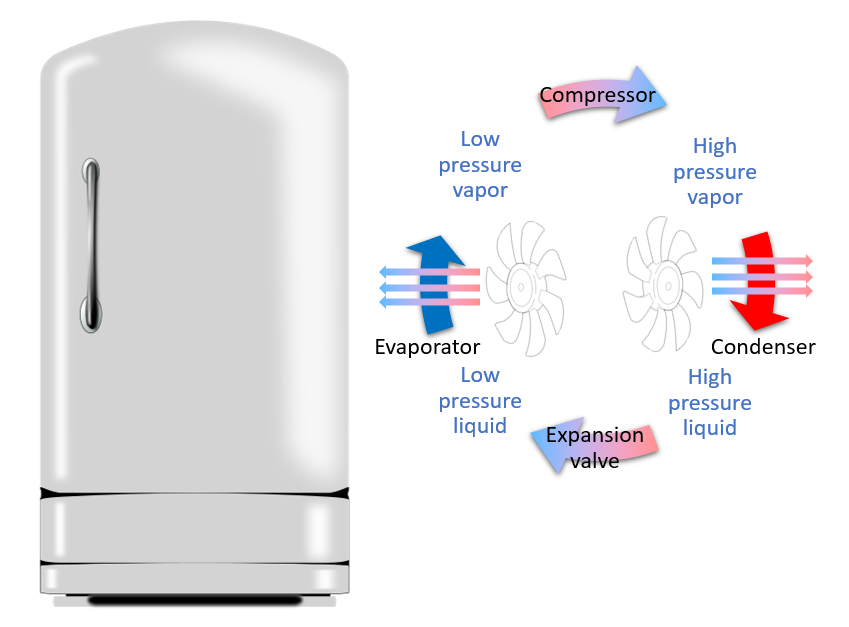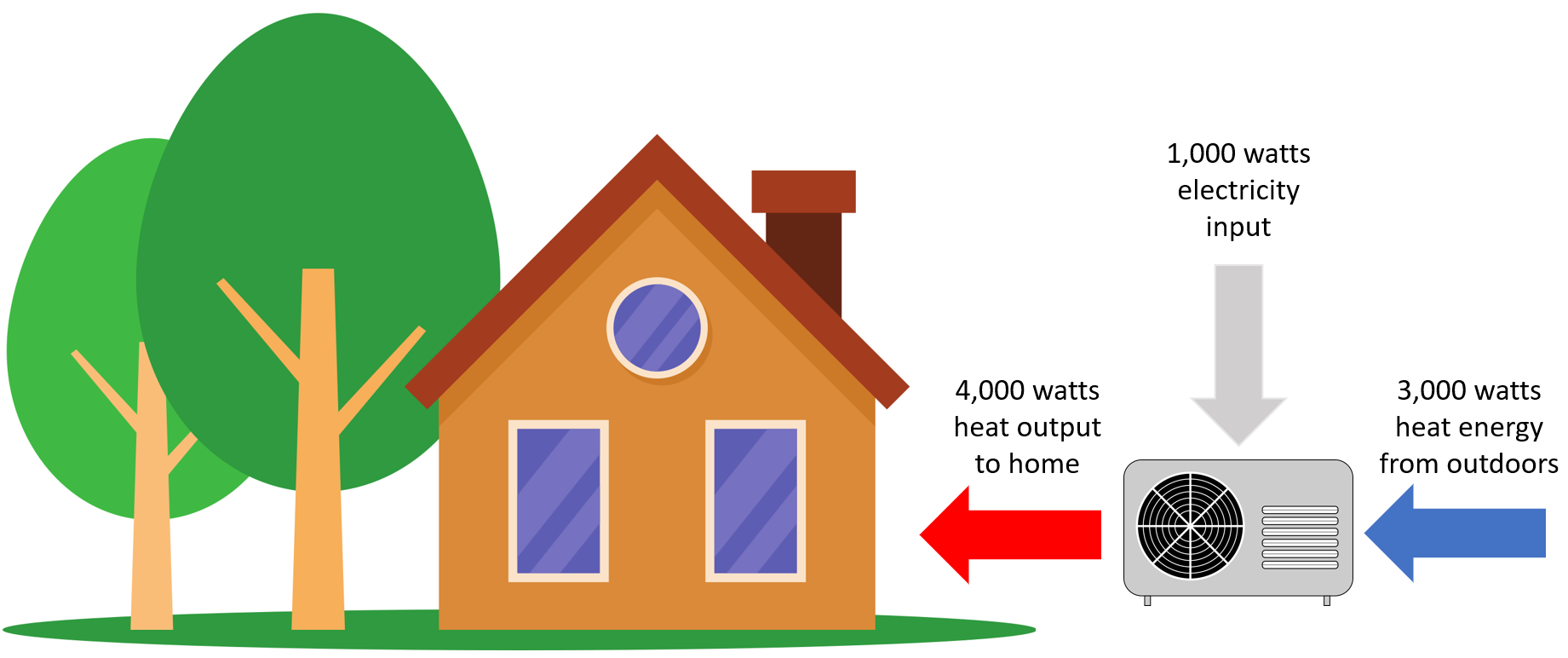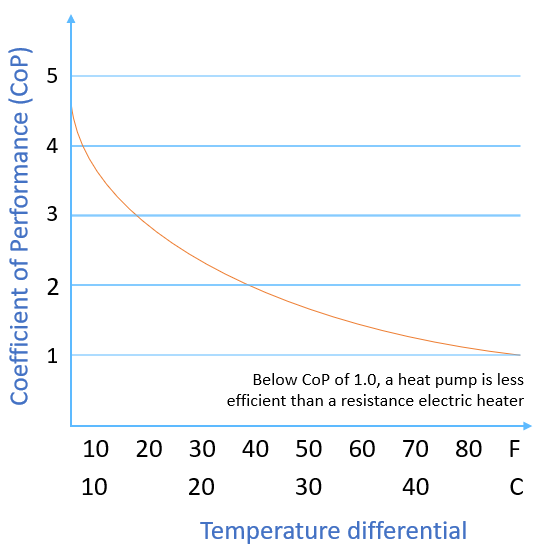One of the things people find puzzling about heat pumps is their apparent ability to be more than 100% efficient. Heat pump efficiency is a bit of a misnomer when a percentage is provided. But if you understand how a heat pump works, you will also understand how it is possible for a heat pump to produce 200% or 450% as much heat energy as it consumes in electrical energy.
When a heat pump is described as 400% efficient, for example, it’s not some kind of magic machine, which creates four units of output heat pump efficiency, for every unit of input energy. Instead, when someone talks about “400% heat pump efficiency”, they mean the heat pump can move four units of heat from one environment (e.g. an indoor or outdoor airspace) to another (e.g. an outdoor or indoor airspace).
How do heat pumps move heat?

Heat pump refrigeration cycle
© Green Energy Efficient Homes Inc
You probably use a heat pump on a daily basis – your refrigerator. When the door is closed and you hear the fridge running, it means a fan is drawing air out of the refrigerated space, blowing it over the heat pump evaporator coils to cool it, and then blowing that cooled air back in the refrigerated space. On the opposite side of the cycle a second fan is blowing outdoor air on the condenser coils to extract the heat out of them and blow it into the airspace of the kitchen, or whatever room the refrigerator is located in. (There may not be a fan on the outside – the condenser side may just rely on passive heat transfer.)
The evaporation/compression cycle in a typical heat pump works as follows (follow the steps clockwies from the top of the diagram):
- Refrigerant is pumped, as a gas or vapor, through a compressor to raise its pressure
- The gas passes through a condenser that is cooled by outside air. This outside air draws heat away from the gas, causing it to condense into a liquid as it cools.
- The high pressure liquid passes through an expansion valve
- As the liquid expands in the evaporator it turns back into gas, cooling in the process. Air is blown over the evaporator, which cools the air and warms the liquid in the evaporator.
- Back to step 1!
Another familiar heat pump example
Now, let’s look at another familiar scenario – a whole-house air conditioner – and compare it to a refrigerator.
Think of the inside of your house as the inside of a refrigerator.
You want the inside of your refrigerator to be cooler than outside it. It is kept cool by having a refrigeration cycle extract heat from the airspace of the refrigerator and transfer it to the surrounding air of the room.
Replace ‘refrigerator’ with ‘home’, and ‘room’ with ‘outdoors’, and you get the idea behind an air conditioner:
You want the inside of your home to be cooler than outside it. It is kept cool by having a refrigeration cycle extract heat from the airspace of the home and transfer it to the surrounding air of the outdoors.
If you’ve ever pondered what a refrigerator or air conditioner does (remove heat from one place and put it somewhere else), then you’ve already grasped the basics of what a heat pump is. (Whether you understand the whole evaporation/condensation cycle matters less than your grasping the basic idea that a heat pump uses energy to move heat between separate spaces.)
Running the air conditioner in reverse
Imagine if you could reorganize the way your air conditioner works, and instead of having it pump heat from your home into the outdoors, you could use it to pump heat from the outdoors into your home on cold days. But how, you ask, is it possible to pump heat from a colder space into a warmer space?
We’ve already seen that it’s possible. The refrigerator is pumping heat from a colder space (the fridge) to a warmer space (the room). The home air conditioner is pumpng heat from a colder space (the house) to a warmer space (the outdoors).
A heat pump for heating your home works in exactly the same way, using the refrigeration cycle to pump heat from the colder space (outdoors) into a warmer space (your home). It uses the same refrigeration cycle involving evaporation and condensation as a refrigerator, freezer or air conditioner. It just takes advantage of the warming part of that cycle rather than the cooling part. In an air conditioner or refrigerator, the warm air is waste heat removed from the space you’re cooling. In a heat pump, the cold air is ‘wasted’ (you can’t really call it ‘waste cold’ since cold is just the absence of heat) and the warm air comng off the condenser is what you’re after.
One great thing about home heat pumps (as opposed to air conditioners) is that they are designed to run both ways: as a heat pump warming your home while cooling the out-of-doors, and as an air conditioner cooling your home while warming the out-of-doors.
Getting back to heat pump efficiency
Now that we understand how a heat pump works, we can review how heat pumps can work to produce more units of heat energy than they consume in units of electrical energy.
A standard electric heater – think of the burner coils on your stove, or a baseboard heater or portable electric heater – works by running electric current through a material that conducts electricity but not completely efficiently – instead the material has enough resistance that the energy in the electricity gets converted to heat. Since energy can’t just come into being or disappear – that’s the second law of thermodynamics for you – all that electric energy has to become something; it becomes heat. A 1,000 watt heater consumes 1,000 watts of electricity and produces 1,000 watts of heat. Pure and simple. Every electric resistance heater is, thanks to the second law, 100% energy efficient.

Heat pump power multiplier
© Green Energy Efficient Homes Inc
But heat pump efficiency can do much better than that, in terms of how much heat it can move from one space to another for a given energy input. If you run a 1,000 watt heat pump (one that consumes 1,000 watts of electricity), in ideal conditions it can extract up to 8 units of heat energy from outdoors and pump it into the house (in most real world scenarios this multiplier is more typically under 5 units of heat energy per unit of input energy). For simplicity’s sake, let’s assume on a typical day, a home heat pump extracts 3,000 watts of heat energy from the outdoors. Let’s also assume that 100% of the electrical input energy for running the heat pump also gets converted into heat, all of which is captured and pumped indoors. In this scenario, the heat pump generates 4,000 watts of heat energy in total, for an input of 1,000 watts of electrical energy. Thus the heat pump efficiency can be described as 400%.
This is a bit of a simplification – skip this paragraph unless you want a more precise understanding. Some, but not all, of the energy used to operate the heat can be recaptured and pumped indoors. The energy used to move the refrigerant around, for instance, ultimately turns into heat, some of which can be extracted and put inside the home. But the energy used to turn the outdoor blower (which passes cool air over the evaporator coils to extract from that air) does not fully enter the refrigeration cycle – some of it is lost as the kinetic energy of turning the fan and blowing the air, and some of the heat produced from running the fan does not enter the heat pump cycle either. The above diagram would probably be more accurate if it showed 1,000 watts of electricity input, 3,500 watts of heat energy from outdoors, 500 watts of waste heat lost from operating the outdoor components of the heat pump, plus (1,000 – 500 wasted = 500) watts of electrical energy converted to heat, entering the house.
Coefficient of Performance or CoP

Heat pump example coefficient of performance
© Green Energy Efficient Homes Inc
Heat pump efficiency depends on the indoor and outdoor conditions. The best way to measure heat pump efficiency is through the Coefficient of Performance metric, or CoP. When we claim a heat pump is 400% efficient, that’s not strictly correct; instead, we should say is CoP is 4.0, meaning it produces 4 units of heat energy for 1 unit of electrical energy used. But you really can’t describe a heat pump as having a CoP of 4.0. The best CoP rating you can get on a heat pump is where the temperature difference between indoor and outdoor air is small. The bigger the gap, the lower the CoP. For example if it’s 0F/-17C outside and a heat pump is heating the indoors to 80F/27C, that’s a gap of 80F or 44C, which means the CoP will be substantially lower than if the outdoor temperature is 60F/16C (with a gap of only 20F or 11C). The smaller the gap, the higher the CoP.
A typical heat pump has a Coefficient of Performance curve that approaches 4 or 5 at low temperature differentials, and dips below 1.0 at very high differentials. A simpler way to put this, in home heating terms, is colder weather means lower efficiency and lower CoP. But as long as that CoP stays above 1.0, the heat pump is more efficient than an electric resistance heater. Below a CoP of 1.0, most heat pump systems automatically switch over to an electric resistance heater if one is included in the setup. (Most ductless minisplit heat pumps have a built-in resistance heater; full-home heat pumps are typically installed with a backup electric resistance heater in colder climates, but not in climates that tend not to dip too far below freezing, because the added cost isn’t justified by the very infrequent times when you’d be running the heatpump below a CoP of 1.0.)
While that bottom edge of the curve might make you worry that heat pump efficiency is a problem in a cold northern climate, you should really focus on typical temperature differentials in your region rather than the extremes. For example, let’s consider a city I’ve chosen at random by looking on a map of the USA colored by January average temperature – Minneapolis Minnesota.
Looking at January 2021, I can see that the lowest temperature recorded was 1F/-17C. Assuming a desired indoor temperature of 72F/22C, that’s a differential of 71F or 39C. Looking at the CoP chart above (which is for an imaginary heat pump – the CoP chart for every heat pump will be somewhat different) you can see that at 70F/40C differential, the CoP is only marginally above 1. On another heat pump, the temperature differential at which CoP drops below 1.0 might be somewhat smaller – say at 60F or 33C difference. But that 1F/-17C event was far from normal even in Minneapolis in winter: in that same month, the daily average temperature was 22F/-6C which for our 72F/22C target is a gap of 50F or 28C, which shows a considerably better CoP. And that’s January. Don’t get me started on March! OK – too late. In Minneapolis in March 2021, the average temperature was 40F, giving a 32F temperature delta from our target of 72F – for a CoP on our hypothetical heat pump well above 2.0.
Beyond CoP – which manufacturers make it notoriously hard to get your hands on – there are three other metrics that are used to measure heat pump effiiciency. Luckily these metrics are more easily obtainable from manufacturer websites / brochures and from the energystar.gov website, they’re just not quite as easy to understand. They are:
Energy Efficiency Ratio (EER): rates the cooling efficiency of an air conditioner or heat pump as a ratio of energy input to cooling output in a standard temperature differential.
Seasonal Energy Efficiency Ratio (SEER): rates the cooling efficiency of an air conditioner or heat pump as a ratio over the duration of a typcial cooling season.
Heating Seasonal Performance Factor (HSPF): rates the heating efficiency of a heat pump over the duration of a typical heating season.
It’s not really important to know the details about the standard temperature differential used for EER, or what the typical heating or cooling seasons are for SEER and HSPF. You just need to understand that these metrics are standardized, so when you go shopping for a heat pump or air conditioner, you can compare different brands and models.
Once you understand heat pump efficiency you’ll be well equipped to start your search for the perfect heat pump. Check out my main article on heat pumps for more information, or for links to other heat pump related topics. Or just click the heat pumps menu item at the top of the page! Happy heating and cooling – and happy cutting your energy bills!

Leave a Reply
Want to join the discussion?Feel free to contribute!